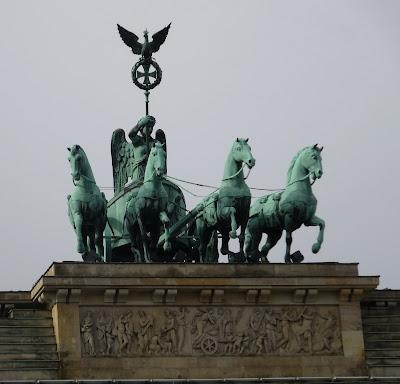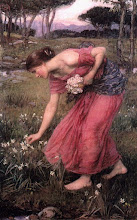Restoration work didn't begin until 2003 and was done by an English architect called David Chipperfield. He used as much of the original building as possible and the scars left by shrapnel and bullet holes were left visible rather than being patched over. The parts that needed to be completely rebuilt were done in modern brick so that the difference between old and new is very obvious. This in itself tells the story of the building. It must have been a very difficult engineering feat as the Museum is built on thousands of wooden foundation piles because of the swampy ground that it stands on. Although I knew that the Museum houses a collection of Egyptian art I didn't realise until too late that the collection includes the beautiful head of Nefertiti. I can't believe that I missed a chance of seeing that!
The Berliner Dom also stands on Museum Island and contains the tombs of the Hohenzollern family who ruled the kingdom of Prussia from 1701 and then the whole of Germany between 1871 and 1918. Like so many other buildings in Berlin it suffered severe damage during WW2 and it remained closed until 1993. It has now been fully restored and is in use both as a church and a venue for concerts.It is apparently well worth seeing the inside but sadly we didn't have time on this visit.
The Altes Museum, built in 1830, stands at right angles to the Berliner Dom overlooking the Lustgarten which started life in the 16th century as the kitchen gardens of the Berliner Stadtschloss or Palace. It was on the central steps leading up to the Altes Museum that a platform was built and from here Adolf Hitler addressed mass rallies of up to a million people. It's almost impossible to imagine those dark events in today's peaceful surroundings.
The row of black blobs above the Doric columns are actually eighteen Prussian eagles. The Black Eagle was the coat of arms of Prussia from 1229 until 1947.
From Museum Island we moved on to Unter Den Linden probably the best known and most elegant street in Berlin. It began life in the mid 1500s as a bridle path leading from the Royal Palace to the hunting grounds in what is now the Tiergarten. Its name comes from the double row of lime trees planted in 1647 by the Grand Elector Frederick William. The original trees had all gone by the end of WW2 and the ones that are there today were planted in the 1950s. The rather splendid equestrian statue is of Frederick the Great who was King of Prussia from 1740 to 1786.
This is a 20th century sculpture called Mother With Her Dead Son by Berlin artist Kathe Kollwitz who lost her own son in WW1. It stands inside a building on Unter Den Linden called Neue Wache which was originally built as a royal guardhouse between 1816 and 1818 but in 1931 it was turned into a memorial to the fallen of WW1. After the reunification of Germany it became a memorial to all victims of war and tyranny. Under the granite slab that the sculpture stands on are the ashes of an unknown soldier, a resistance fighter, a concentration camp prisoner and soil from battlefields and concentration camps. It's a very compelling memorial standing in the centre of a large empty stone lined chamber and above it is a circular skylight open to the elements.
Just off Unter Den Linden is Bebelplatz which contains The Staatsoper, Berlin's Opera House, St Hedwig's Cathedral and the lovely Baroque building in the photograph which is the Altes Bibliothek or Old Library which was built about 1775. It's now part of Humboldt University.
Bebelplatz is a very attractive place especially in the early morning sunshine but this too has a dark history. On May 10th 1933 the centre of this pleasant square was the scene of the burning of over 20,000 books by authors deemed to be enemies of the Third Reich. These included works by Thomas Mann, Ernest Hemingway and Erich Maria Remarque (who wrote All Quiet On The Western Front), Franz Kafka, Albert Einstein and Leo Tolstoy. The photo shows the monument created in 1995 which commemorates this event, it's a window set into the cobbled surface of the square and to begin with you can see nothing then you realise that below are rows and rows of empty bookshelves - enough to hold the 20,000 books that were burned.
The Hotel Adlon - the most luxurious hotel in Berlin. This is where Queen Elizabeth stayed during her State visit to Germany earlier this year. The original Hotel Adlon was built in 1907 and became the social centre of Berlin, famous people who stayed there include Czar Nicholas II, Henry Ford, Charlie Chaplin and Marlene Dietrich.It survived WW2 virtually undamaged but was destroyed in 1945 by a fire started by drunken Red Army soldiers! The current Hotel Adlon was re-opened in 1997.
Right at the end of Unter Den Linden stands what is probably Berlin's most famous landmark - the Brandenburg Gate. It was built in the late 18th century and stands on the site of one of Berlin's old city gates.
The Quadriga stands on top of the Gate but it hasn't spent all its life here nor has the goddess Victory always carried the staff bearing the Prussian Eagle and the Iron cross . During the Napoleonic Wars Berlin was occupied by the French for a few years and Napoleon took a fancy to the Quadriga and had it taken to Paris. It remained there until 1814 when it was returned to Berlin after Prussian, Austrian and Russian troops occupied Paris. It was on its return to Berlin that the Prussian Eagle and Iron Cross were added.
From there we were then taken to see the site of Hitler's Bunker which is now a car park, had a brief look at the Berlin Wall and were marched smartly past Checkpoint Charlie with the scathing remark that the whole thing was a complete sham and not even in quite the right place but how accurate that statement is I've no idea:)
Our tour ended in Gendarmenmarkt outside the Konzerthaus, it was interesting and we learned a lot but there was no time to linger or actually go inside places. These tours do give you an idea of what there is to see and the layout of the main part of the city though. By this time it was nearly 2pm and we'd been walking since 10.30 with just a 15 minute break which gave time to either have a quick bite to eat or visit the restroom and buy a quick drink. We chose the second option! By now we were ready to eat and ready to sit down for a while and we knew the perfect place to do both just a stone's throw away. Fassbender and Rausch was on out list of must visit places anyway so we decided to have a leisurely and rather belated lunch there.
A little appetizer on the house while we waited for the main course - we were halfway through it before I thought of taking a photo. Cream cheese with chocolate - delicious! Everything in the cafe involves chocolate in one way or another.
A nice healthy salad of wild herbs with goat's cheese pralines - except that the salad is served in a basket made of chocolate:)
Dessert - an orange brittle mini torte that was incredibly rich. My daughter had a Mozart Symphony. All washed down with a glass of Prosecco. By the time I'd finished I felt that I never wanted to eat again:)
When we eventually got back downstairs we saw the Brandenburg Gate again - Fassbender and Rausch are famous for their chocolate sculptures. I regret to say that we spent rather a lot of euros in the shop and, even worse, I've discovered that they have an online shop that ships to all countries in the EU. I see lots of pralines and truffles in my future!
I'm off to Suffolk for a few days on Thursday but when I get back I'll post about out Food Tour of Berlin and more about the Berlin Wall which we revisited on the Sunday. By the way have you noticed that many of the outdoor photos have a crane in them? There is still much rebuilding going on in East Berlin.
























































